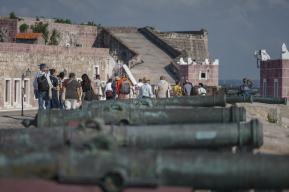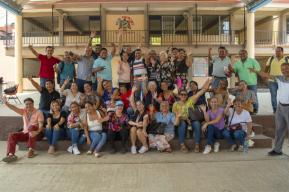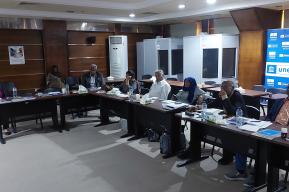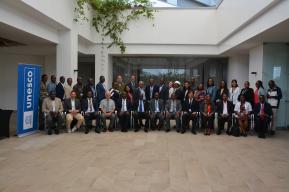News
UNESCO announces winners of 2023 Asia-Pacific Awards for Cultural Heritage Conservation
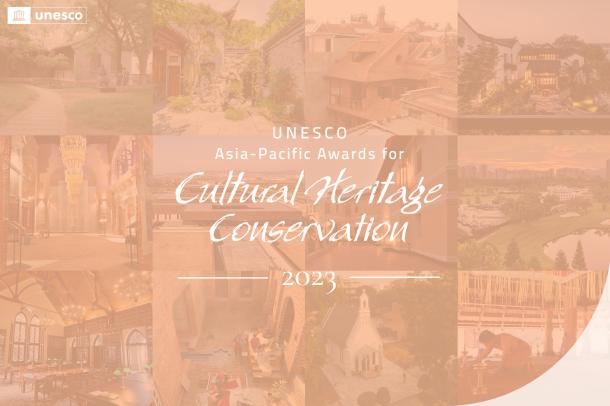
With people, heritage and creativity at its core, the resilient urban revitalization of the Rambagh Gate and Ramparts in Punjab, India, has garnered the highest honour, ‘Award of Excellence’, in this year’s UNESCO Asia-Pacific Awards for Cultural Heritage Conservation. The project was lauded by this year’s Awards jury for ensuring the continuity of the site’s existing uses, while enhancing inclusivity and access for the broader community.
Through a deliberation process carried out in November 2023, the jury selected a total of 12 projects on the basis of their understanding of place, their technical achievements, and their sustainability and impact, as specified in the Awards Criteria.
Three projects, namely the Fanling Golf Course in Hong Kong SAR, China; Dongguan Garden Residences in Yangzhou, China; and Karnikara Mandapam at Kunnamangalam Bhagawati Temple, Kerala, India, garnered an Award of Distinction. Five projects were recognized with an Award of Merit, including Yan Nan Yuan, at Peking University, Beijing, China; Pan Family Residence, in Suzhou, China; Church of Epiphany, in Haryana, India; David Sassoon Library and Reading Room, in Mumbai, India; and Bikaner House, in New Delhi, India.
The Award for New Design in Heritage Contexts went to Erlitou Site Museum of the Xia Capital, in Luoyang, China.
The Karnikara Mandapam at Kunnamangalam Bhagawati Temple, in Kerala, India; Pipal Haveli, in Punjab, India; and Sikami Chhen, in Kathmandu, Nepal, were awarded with the Special Recognition for Sustainable Development for their transformative heritage practices which contribute to larger principles of sustainable development.
This year, the jury reviewed 48 project entries from 8 countries across the Asia-Pacific region. Entries were notably diverse in scope and typology. The jury noted that, taken together, all entries collectively represent significant ongoing progress in heritage conservation awareness and practice in the region.
The Awards jury in 2023 was composed of seven international conservation experts directed by a chair. The geographical representation of the jury members spanned the Asia-Pacific region, just as jurors’ expertise—archaeology, intangible cultural heritage, landscape design, museology, built heritage conservation—reflected a wide range of perspectives.
Every year, since 2000, the UNESCO Asia-Pacific Awards for Cultural Heritage Conservation programme has been recognizing the efforts of private individuals and organizations in restoring, conserving, and transforming structures and buildings of heritage value in the region. By acknowledging private efforts to restore and adapt historic properties, the Awards programme encourages others to undertake conservation projects within their own communities, whether independently or through public-private partnerships (PPPs).
UNESCO introduced the new category, ‘Special Recognition for Sustainable Development’, in 2020, together with an updated set of Awards Criteria to acknowledge the role and contribution of cultural heritage to sustainable development within the broader framework of the UN 2030 Agenda.
The awarded projects serve as a testament to how cultural heritage can be successfully preserved whilst at the same time mobilized to be integrated into various local development strategies.
The Award winners were selected according to their demonstration of success among various conservation criteria, such as their articulation of the spirit of place, their technical achievement, their appropriate use or adaptation, their engagement with the local community, and their contribution towards enhancing the sustainability of the surrounding environment and beyond.
For further information about the UNESCO Asia-Pacific Awards for Cultural Heritage Conservation and upcoming related events, please visit the Awards page.
The Call for Entries for the 2024 UNESCO Awards cycle will be announced in early 2024; further details will be available on the UNESCO Bangkok website pages.
UNESCO welcomes the participation of projects of underrepresented countries and heritage typologies from across the region.
High-resolution images of 2023 Award recipients are available here.*
* This link will be accessible online for around three months after the announcement was first published. To access the images after that, please write to heritageawards(at)unesco.org.
Citations of the 12 award-winning projects
#HeritageAwards
Award of Excellence
- Rambagh Gates and Ramparts, Punjab, India
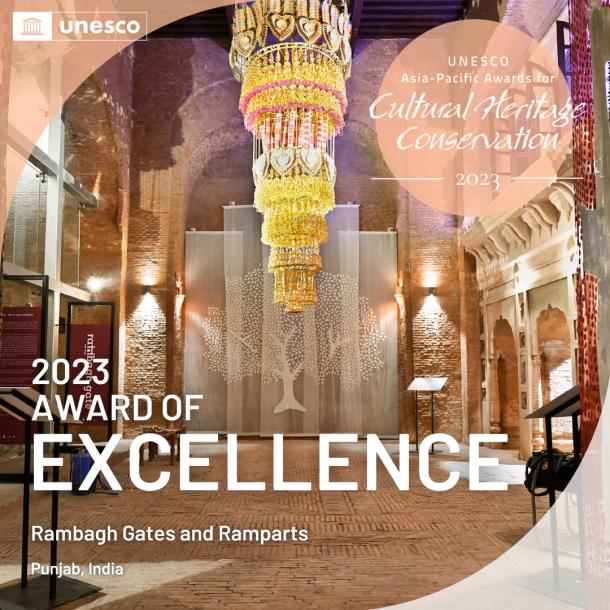
Rambagh Gates and Ramparts
Location: Punjab, India
With people, heritage and creativity at its core, the Rambagh Gate and Ramparts project demonstrates an exceptional model for an inclusive and resilient urban revitalization. Strategically located at the intersection of the Maharaja Ranjit Singh's nineteenth-century city wall and the new city of Amritsar, the three-storied structure was competently restored for its continued use by the historical gate community as a traditional market, a government school, and a municipal printing press. The project reversed centuries-old deterioration and revived the original form and materiality by employing traditional building techniques and locally produced materials, such as the characteristic Nanakshahi bricks set in lime mortar. Beyond structural restoration and social infrastructure upgrades for improved working and learning environments within the gate and the surrounding locality, active public engagement has established a sense of pride and collective identity to the community, thereby reinstating the historical property as a major platform for cultural exchange. Driven by an exemplary people-centered approach for conservation, this project has not only reconnected the local authorities and the diverse host communities—including marginalized groups—but has also paved the way for fostering a vibrant and uniquely localized cultural experience of the historical city through contemporary interpretations using arts, media and other creative approaches.
Award of Distinction
- Fanling Golf Course, Hong Kong SAR, China
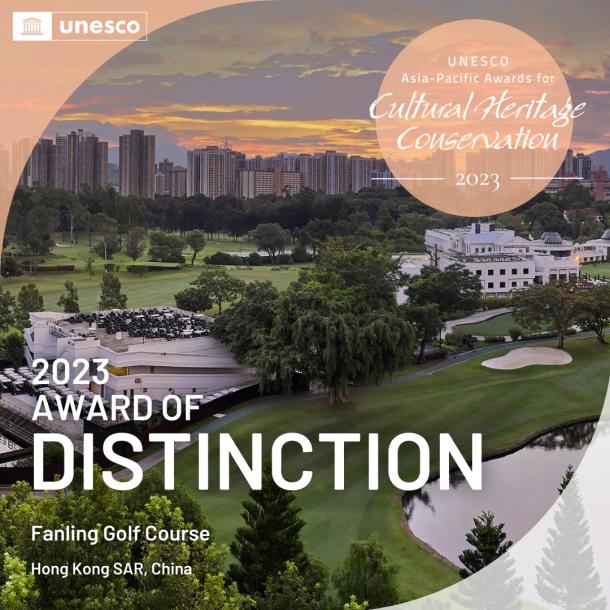
Fanling Golf Course
Location: Hong Kong SAR, China
The multi-disciplinary effort of the Fanling Golf Course project has strengthened the socio-ecological commitment and ‘people-nature-culture’ relationship of Greater China’s oldest championship golf course, establishing a welcome precedent for conserving a unique typology of landscape heritage, one located amid increasingly urbanized surroundings and subject to larger developmental pressures. Epitomizing a commendable undertaking for environmental stewardship, the landscape conservation management plan entailed numerous technical studies which strategically incorporated strengthened ecological values and biodiversity preservation measures, while enhancing heritage interpretation and community outreach components for attaining a holistic management of the site. The project brought together diverse living and non-living, tangible and intangible, attributes of the heritage property with the zeitgeist of the site’s origin and historic role within the Hong Kong community, allowing the continuation of local ancestral worship practices on-site. Moreover, this project created a narrative and a range of activities for a wide public, inclusive of golfers and non-golfers alike, and regardless of age and membership standing. The Fanling Golf Course project thus represents a major advancement in the promotion of an inclusive conservation management approach for cultural landscapes in both Hong Kong and the larger region.
- Dongguan Garden Residences, Yangzhou, China
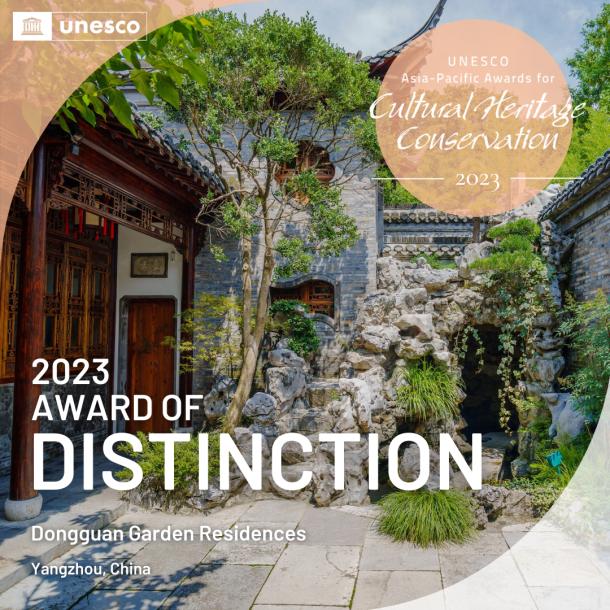
Dongguan Garden Residences
Location: Yangzhou, China
The Dongguan Garden Residences project, a series of restorations of historic gardens along Dongguan Street, has successfully catalysed a revival of Yangzhou’s time-honoured garden-making tradition which reflects a period of the city’s historical development during the Ming and Qing dynasties. The project showcases a sensitive consolidation of traditional craftsmanship and contemporary landscape architectural design for the restoration of gardens of various scale, and in association with different building typologies, thereby setting a standard for technical excellence in classical Chinese garden conservation. The establishment of associations led by garden historians and enthusiasts, along with administrative support and financial incentives provided by the local government, have fueled a community-driven revival of the Chinese residential garden tradition for private courtyard houses in Yangzhou. The multiplicity of the revived gardens reflects the project’s impactful methodology which galvanizes community participation and contributes to broader socio-economic objectives, driving the revitalization of a town’s environmental setting and historic cultural landscape.
- Karnikara Mandapam, Kunnamangalam Bhagawati Temple, Kerala, India
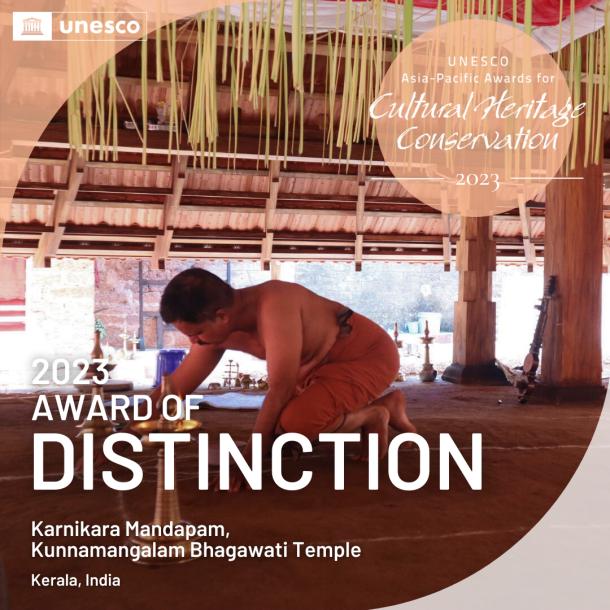
Karnikara Mandapam, Kunnamangalam Bhagawati Temple
Location: Kerala, India
The revival of Karnikara Mandapam, a semi-open, wooden-pillared prayer hall at the heart of the Kunnamangalam Bhagawati Temple complex in Kerala, stands as a testament to the unwavering commitment of the local community to ensure the temple's continuity as a place of worship and gathering. Overcoming challenges such as a lack of legal protection, as well as financial constraints, the project enabled the repair of the timber structure while preserving its original form and spatial quality, and while reinforcing its traditional character, function, spirit, and feeling. The restoration was adroitly carried out to coincide with the temple’s annual festival calendar, adhering to a rigorous conservation approach based on the ancient Hindu architectural system of Vastushastra. The project has upheld the spiritual significance of a sacred temple and supported the livelihoods of local craftspeople. In this regard, this modest project has inspired the community to become ardent custodians of all structures within the larger temple complex, which together contribute to the holistic religious setting. The restored sanctuary establishes an admirable grassroots model for transmitting the cultural legacy of Karnikara Mandapam and other living religious sites across India and beyond.
Award of Merit
- Yan Nan Yuan in Peking University, Beijing, China
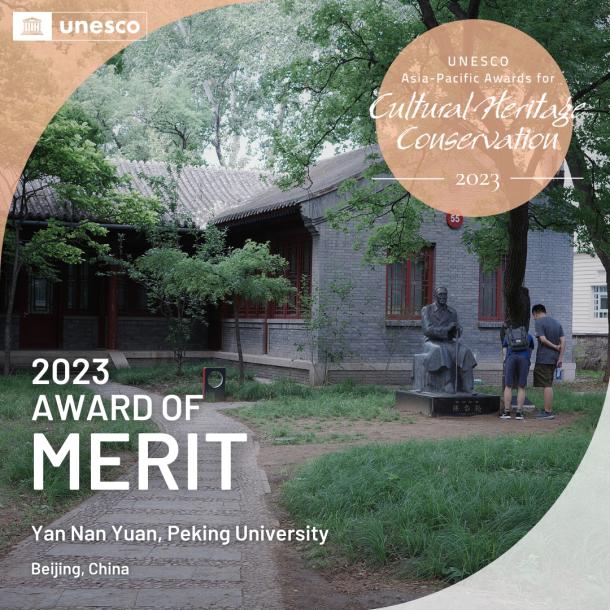
Yan Nan Yuan, Peking University
Location: Beijing, China
The restoration of Yan Nan Yuan, a historical compound of housing and gardens nestled in the bustling campus of Peking University, has deftly encapsulated the spirit of the university’s humble origins from which it has grown into one of China’s premier educational institutions. Through a restrained and academically-informed approach, the spatial, architectural and ecological integrity of the buildings and landscape was sensitively articulated without excessive interventions. The effort to rededicate the site as a space for university students and faculty to remember and honour the heritage of their teachers and academic pioneers was led by a commendable participatory process. A tripartite team of school departments engaged with various members of the campus community to identify Yan Nan Yuan's unique character, and to preserve its historical essence amidst the university’s rapidly developing and modernizing site. With stakeholder engagement at its core, this project inspires members of the university community to value collective memory and to be committed to conserving Yan Nan Yuan and other campus buildings which represent the institution’s illustrious history of scholarship, as well as the enduring legacy of its founding.
- Pan Family Residence, Suzhou, China
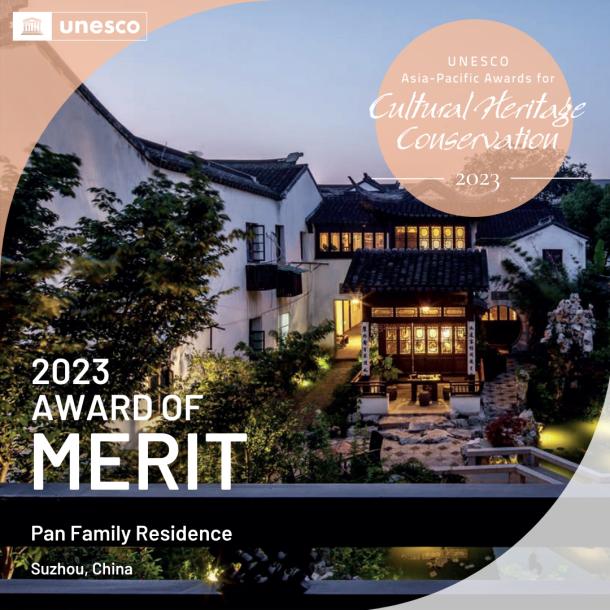
Pan Family Residence
Location: Suzhou, China
The conservation and revitalization of the Pan Family Residence into a mixed-use cultural venue make for an exemplary model in Suzhou, where numerous historic garden residences grapple with finding a relevant contemporary function which respects the cultural identity of the site. Since the 1950s, a series of inappropriate uses and lack of maintenance had caused the Qing dynasty Pan Family Residence to fall into disrepair. While closely adhering to the traditional Xiangshan Group wood-frame craftsmanship for the structural restoration, the project improved the livability and energy efficiency of the residence by introducing innovative technological solutions. The project’s thoughtful repurposing of the historical buildings, gardens and courtyards into a boutique hotel, a heritage interpretation center for the public, and a conservation studio, positions the site as a living testament to Suzhou's traditional way of life. The project underscores the viable potential of these historic garden mansions, thus serving as a beacon for the preservation of Suzhou's rich nineteenth-century heritage.
- Church of Epiphany, Haryana, India
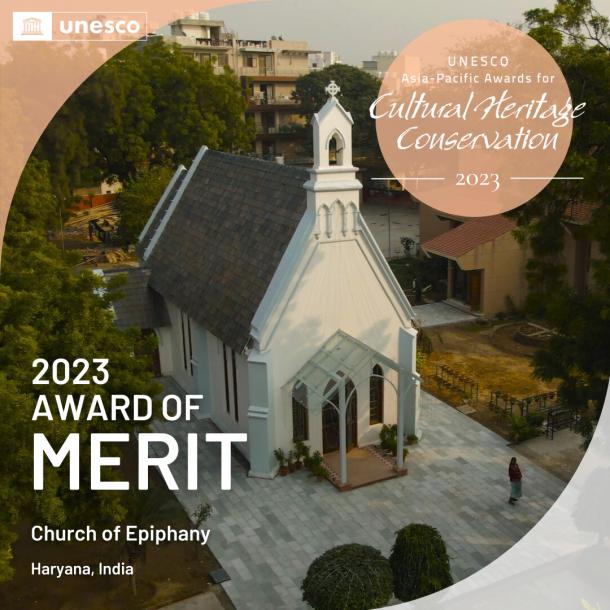
Church of Epiphany
Location: Haryana, India
Initiated by the Church Committee with support from its Parish, the bottom-up restoration of the Church of Epiphany carefully retained the authenticity and functionality of a historic asset of distinct local significance. The project team adeptly introduced a values-based heritage management system, applying non-invasive interventions to counter the deterioration of the church due to age and weathering. It is notable that all decision-making was guided by a meticulous conditions assessment and documentation process, as well as by multiple stakeholder consultations, which ensured a high level of collaboration between the various user groups and technical experts. As an integral part of the project, local craftspeople were trained in traditional building materials and techniques essential for working on sites featuring this distinctive typology. Located in the historic part of Gurugram, the refurbished church is a model conservation project that is expected to catalyse a multiplier effect in the area.
- David Sassoon Library and Reading Room, Mumbai, India
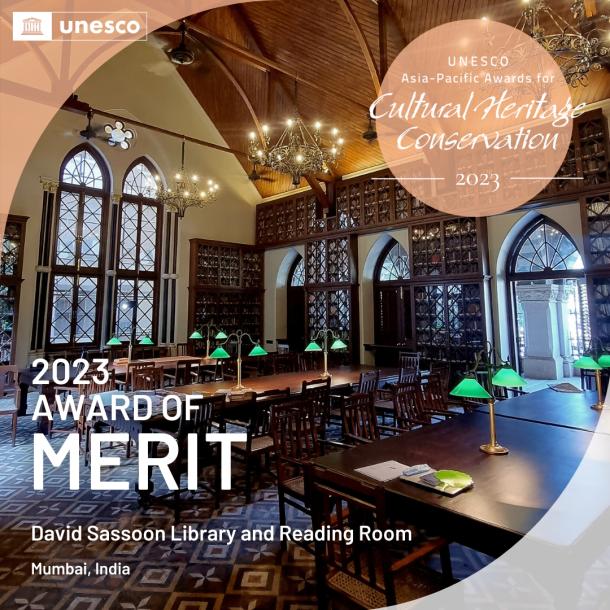
David Sassoon Library and Reading Room
Location: Mumbai, India
The careful restoration of the David Sassoon Library and Reading Room has revived the Victorian aesthetic of a nineteenth-century Gothic architectural gem in the heritage heart of Mumbai. One of the oldest institutions in the city, the library had suffered from prolonged water leakage and timber deterioration which left its collection of rare, archival books vulnerable to damage. Based on historical documentation, the project confidently reversed past inappropriate interventions and reintroduced the original high-pitched roof, thus reinforcing the visual, structural, and spatial integrity of the stately building. The refurbishment of interior fittings and furnishings contributed to bringing back the distinctive character of the Reading Room to its former grandeur. Accomplished through an array of partnerships encompassing corporations, citizen groups, local associations, and a consulate, this collective effort ensures that the celebrated David Sassoon Library will continue to serve its educational and cultural purposes for the entire Mumbai community.
- Bikaner House, New Delhi, India
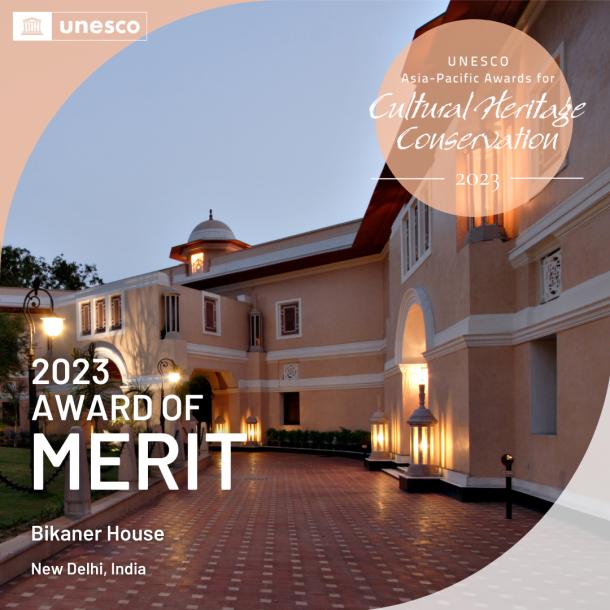
Bikaner House
Location: New Delhi, India
The revitalization of Bikaner House, spearheaded by an alliance of local government entities, private corporations, and the creative sector, has saved the palace from disrepair and lent it new life as a cultural hub along the historic axis of New Delhi. Constructed in the 1930s, Bikaner House had undergone a series of insensitive adaptations for it to serve as a bus terminal, a tourism office, and subsequently as government offices. Consulting archival photographs, the project team reversed layers of inappropriate additions and reinstated the original form of the building with sound technical competence entailing the use of like-for-like materials and traditional artisanal techniques. The interior space and facilities were upgraded to accommodate the venue’s new function as a platform to showcase Indian arts and culture, particularly Rajasthani crafts. The project is commendable for providing a viable case for repurposing early twentieth-century architecture in a prime setting as a vibrant cultural landmark.
Special Recognition for Sustainable Development
- Karnikara Mandapam, Kunnamangalam Bhagawati Temple, Kerala, India
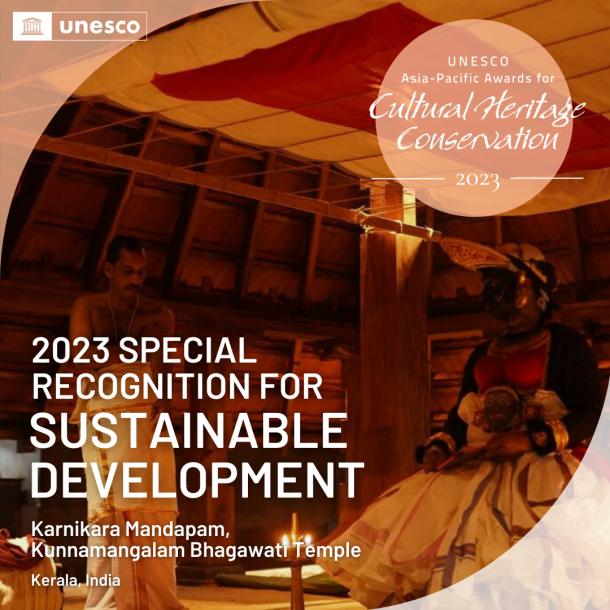
Karnikara Mandapam, Kunnamangalam Bhagawati Temple
Location: Kerala, India
The revival of Karnikara Mandapam, a semi-open, wooden-pillared prayer hall at the heart of the Kunnamangalam Bhagawati Temple complex in Kerala, stands as a testament to the unwavering commitment of the local community to ensure the temple's continuity as a place of worship and gathering. Overcoming challenges such as a lack of legal protection, as well as financial constraints, the project enabled the repair of the timber structure while preserving its original form and spatial quality, and while reinforcing its traditional character, function, spirit, and feeling. The restoration was adroitly carried out to coincide with the temple’s annual festival calendar, adhering to a rigorous conservation approach based on the ancient Hindu architectural system of Vastushastra. The project has upheld the spiritual significance of a sacred temple and supported the livelihoods of local craftspeople. In this regard, this modest project has inspired the community to become ardent custodians of all structures within the larger temple complex, which together contribute to the holistic religious setting. The restored sanctuary establishes an admirable grassroots model for transmitting the cultural legacy of Karnikara Mandapam and other living religious sites across India and beyond.
- Pipal Haveli, Punjab, India
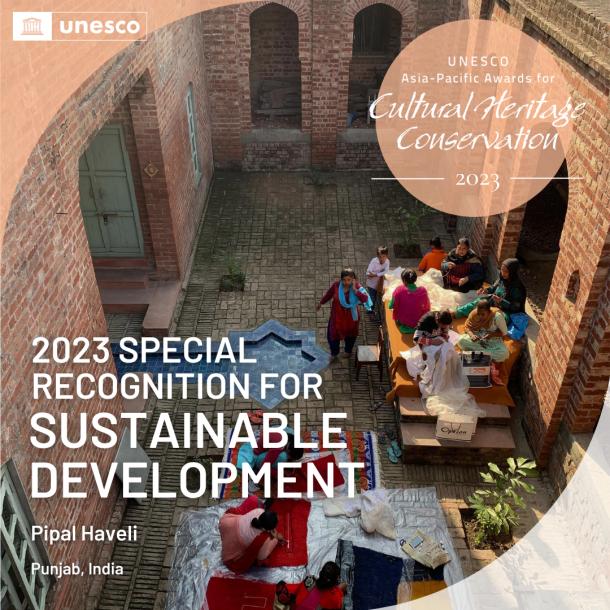
Pipal Haveli
Location: Punjab, India
Situated inside a historic ‘haveli’, or gated precinct, Pipal Haveli is a contemporary community-centered, multi-use educational building rooted in time-honoured principles of sustainability. This new building, located in rural Punjab, emphasizes ecological and traditional building methods, as well as construction techniques that utilize locally-sourced materials and vernacular architectural language. The villagers’ rich traditions of building and craft production, including earthen construction, carpentry, weaving, and embroidery, were mapped by the project team, and have been integrated into the design and functionality of the new haveli. As a hub for the sharing of knowledge across generations, Pipal Haveli supports the empowerment of women in the village through initiatives such as the BaRi Collective, which offers programmes for artists and creatives to learn and work together within the Pipal Haveli complex to strengthen women’s livelihood opportunities through environmentally conscious craft practices. This project serves as an example of how the strength of nature and culture together may be a resilient, transformative force for community enrichment and economic prosperity.
- Sikami Chhen, Kathmandu, Nepal
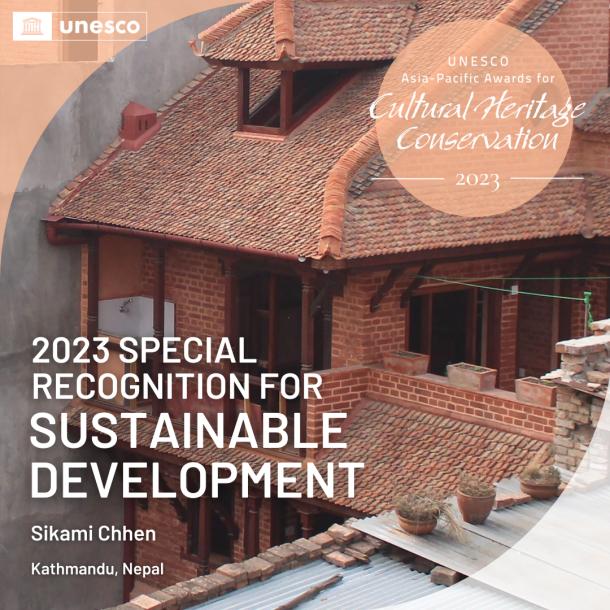
Sikami Chhen
Location: Kathmandu, Nepal
The heroic reconstruction of the Sikami Chhen, built on the premises of a 200-year-old residence within the Kathmandu Valley World Heritage town of Bhaktapur, stands as an inventive and culturally authentic response to the devastating impact of the 2015 Gorkha earthquake. Following the demolition of the original building due to irreparable structural instability, the owner-artisans adroitly adapted age-old building techniques, using their traditional knowledge of brick and timber-frame architecture, to design a new house that meets the stringent safety regulations now governing the construction of new private residences in Nepal. Integrating modern craftsmanship such as steel-reinforced brick masonry into the vernacular architectural vocabulary, the newly-built Sikami Chhen prioritizes seismic protection while preserving the unique character of Bhaktapur’s historic architecture. The family of woodcarvers continues to perform and showcase the transformative practice of Bhaktapur’s woodcarving tradition at the in-situ workshop. The project has enhanced the overall well-being of the community, creating a safer, more resilient, and culturally enriched addition to the town’s built environment, and providing a viable example for a heritage-based approach to modern construction at other earthquake-affected historic districts in the region.
Award for New Design in Heritage Contexts
- Erlitou Site Museum of the Xia Capital, Luoyang, China
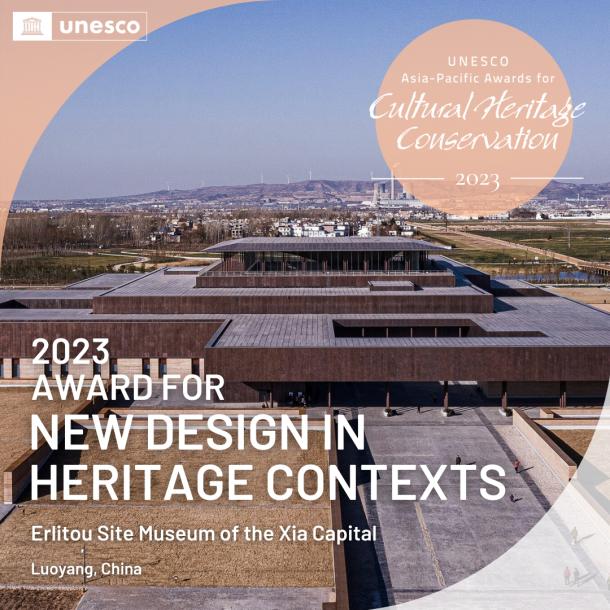
Erlitou Site Museum of the Xia Capital
Location: Luoyang, China
The ambitious Erlitou Site Museum has elegantly tackled the daunting conservation and interpretive challenges implied in designing an archaeological site museum at an expansive heritage site without visible in-situ structural remains or any distinctive above-ground feature. Through a well-considered understanding of the formidable conservation imperatives of a buried archaeological site, the museum is situated a short 500 meters southwest of the excavated remains of the former capital of China’s Xia dynasty. Inspired by important archaeological discoveries including the earliest bronze workshop in China, and many earth-built palaces found on site, the museum was constructed using age-old building materials such as rammed earth, and was adorned with bright copper and bronze fittings. In addition, the spatial display of artefacts embedded within the walls of the museum attempts to provide a true immersive and educational experience for visitors. The Erlitou Site Museum sets a benchmark for integrating museological functions into the overall archaeological site preservation plan through an interplay of creative concepts that enhances the holistic comprehension of the site’s significance, while contributing to a paradigm for rural development in surrounding village settlements.






